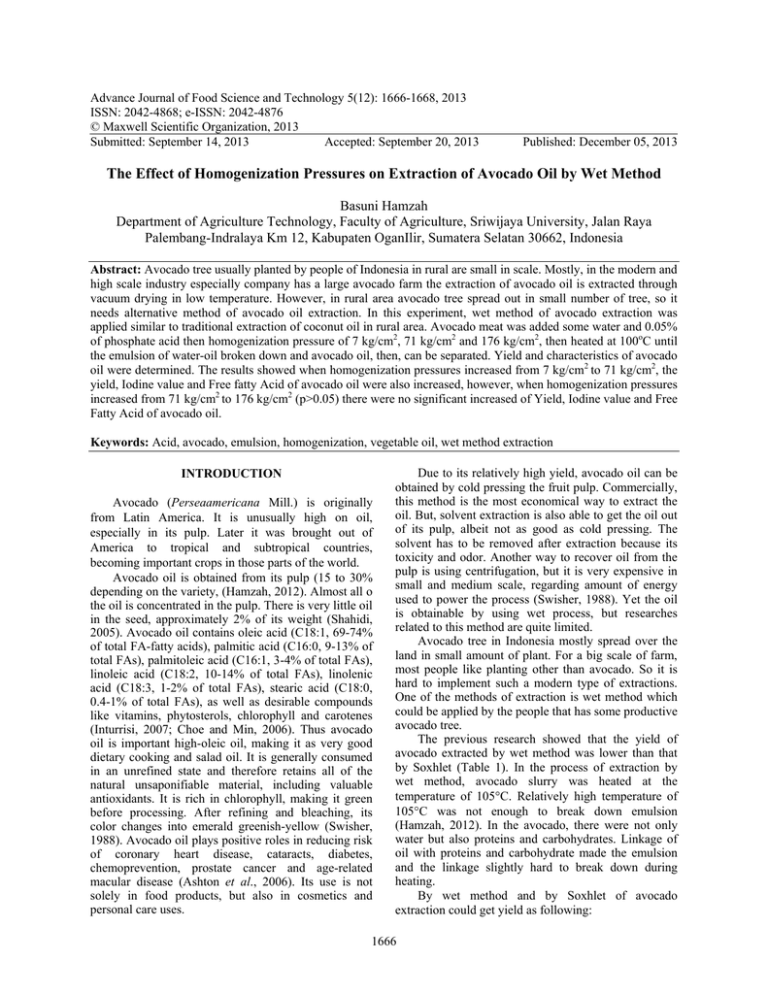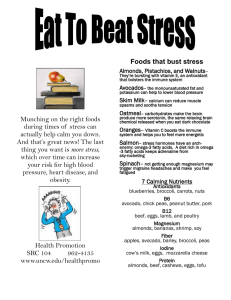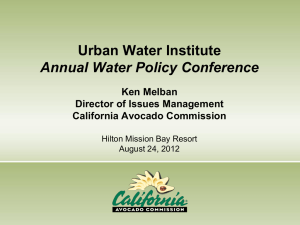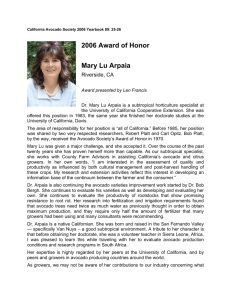Advance Journal of Food Science and Technology 5(12): 1666-1668, 2013
advertisement

Advance Journal of Food Science and Technology 5(12): 1666-1668, 2013 ISSN: 2042-4868; e-ISSN: 2042-4876 © Maxwell Scientific Organization, 2013 Submitted: September 14, 2013 Accepted: September 20, 2013 Published: December 05, 2013 The Effect of Homogenization Pressures on Extraction of Avocado Oil by Wet Method Basuni Hamzah Department of Agriculture Technology, Faculty of Agriculture, Sriwijaya University, Jalan Raya Palembang-Indralaya Km 12, Kabupaten OganIlir, Sumatera Selatan 30662, Indonesia Abstract: Avocado tree usually planted by people of Indonesia in rural are small in scale. Mostly, in the modern and high scale industry especially company has a large avocado farm the extraction of avocado oil is extracted through vacuum drying in low temperature. However, in rural area avocado tree spread out in small number of tree, so it needs alternative method of avocado oil extraction. In this experiment, wet method of avocado extraction was applied similar to traditional extraction of coconut oil in rural area. Avocado meat was added some water and 0.05% of phosphate acid then homogenization pressure of 7 kg/cm2, 71 kg/cm2 and 176 kg/cm2, then heated at 100oC until the emulsion of water-oil broken down and avocado oil, then, can be separated. Yield and characteristics of avocado oil were determined. The results showed when homogenization pressures increased from 7 kg/cm2 to 71 kg/cm2, the yield, Iodine value and Free fatty Acid of avocado oil were also increased, however, when homogenization pressures increased from 71 kg/cm2 to 176 kg/cm2 (p>0.05) there were no significant increased of Yield, Iodine value and Free Fatty Acid of avocado oil. Keywords: Acid, avocado, emulsion, homogenization, vegetable oil, wet method extraction INTRODUCTION Avocado (Perseaamericana Mill.) is originally from Latin America. It is unusually high on oil, especially in its pulp. Later it was brought out of America to tropical and subtropical countries, becoming important crops in those parts of the world. Avocado oil is obtained from its pulp (15 to 30% depending on the variety, (Hamzah, 2012). Almost all o the oil is concentrated in the pulp. There is very little oil in the seed, approximately 2% of its weight (Shahidi, 2005). Avocado oil contains oleic acid (C18:1, 69-74% of total FA-fatty acids), palmitic acid (C16:0, 9-13% of total FAs), palmitoleic acid (C16:1, 3-4% of total FAs), linoleic acid (C18:2, 10-14% of total FAs), linolenic acid (C18:3, 1-2% of total FAs), stearic acid (C18:0, 0.4-1% of total FAs), as well as desirable compounds like vitamins, phytosterols, chlorophyll and carotenes (Inturrisi, 2007; Choe and Min, 2006). Thus avocado oil is important high-oleic oil, making it as very good dietary cooking and salad oil. It is generally consumed in an unrefined state and therefore retains all of the natural unsaponifiable material, including valuable antioxidants. It is rich in chlorophyll, making it green before processing. After refining and bleaching, its color changes into emerald greenish-yellow (Swisher, 1988). Avocado oil plays positive roles in reducing risk of coronary heart disease, cataracts, diabetes, chemoprevention, prostate cancer and age-related macular disease (Ashton et al., 2006). Its use is not solely in food products, but also in cosmetics and personal care uses. Due to its relatively high yield, avocado oil can be obtained by cold pressing the fruit pulp. Commercially, this method is the most economical way to extract the oil. But, solvent extraction is also able to get the oil out of its pulp, albeit not as good as cold pressing. The solvent has to be removed after extraction because its toxicity and odor. Another way to recover oil from the pulp is using centrifugation, but it is very expensive in small and medium scale, regarding amount of energy used to power the process (Swisher, 1988). Yet the oil is obtainable by using wet process, but researches related to this method are quite limited. Avocado tree in Indonesia mostly spread over the land in small amount of plant. For a big scale of farm, most people like planting other than avocado. So it is hard to implement such a modern type of extractions. One of the methods of extraction is wet method which could be applied by the people that has some productive avocado tree. The previous research showed that the yield of avocado extracted by wet method was lower than that by Soxhlet (Table 1). In the process of extraction by wet method, avocado slurry was heated at the temperature of 105°C. Relatively high temperature of 105°C was not enough to break down emulsion (Hamzah, 2012). In the avocado, there were not only water but also proteins and carbohydrates. Linkage of oil with proteins and carbohydrate made the emulsion and the linkage slightly hard to break down during heating. By wet method and by Soxhlet of avocado extraction could get yield as following: 1666 Adv. J. Food Sci. Technol., 5(12): 1666-1668, 2013 Table 1: The amount of avocado oil extracted by wet method and Soxhlet method Method of avocado oil extraction ---------------------------------------------------Yield (%) Wet method Soxhlet 20.06 29.74 Table 2: Characteristics of avocado oil extracted by wet method and the Soxhlet Method of avocado oil extraction --------------------------------------------Characteristics Wet Method Soxhlet Iodine value (Wijs), 78.0 76.4 Saponication Value 192 194 Acid value 1.72 1.77 Peroxide (milli-equivalents 3.3 3.5 of peroxide per 1000 g oil) Free fatty acid 0.84% 1.54% Specific gravity at 25oC 0.918 0.917 Refractive index at 25oC, 1.493 1.499 Smoke point 181°C 181°C Cloud point -15°C -15°C Flash point 245°C 245°C Unsaponifiable 1.58% 1.56% In Table 2 there were not much differences characteristics of avocado oil between wet method extraction and the Soxhlet, except for free fatty acid. Free fatty acid of avocado extracted from wet method was higher than that from Soxhlet. The higher content of free fatty acid in avocado oil extracted from wet method probably due to hydrolysis of some fatty acid in which the process using relatively high temperature (105°C) (Hamzah, 2012). METHODS AND MATERIALS Wet method of extraction: Flesh part of avocado mixed with water with the proportion of 1:1 (w/w) and 0.05% of phosphate acid was added. The mixture then was homogenized by the use of blender (5000 RPM for 3 min) then homogenization pressure of 7 kg/cm2, 71 kg/cm2 and 176 kg/cm2 were applied in order in the following processed to be much easier to break down water in oil emulsion. The homogenization mixture then was heated to 105°C until oil part significantly separated. And the data obtained could be used to determine the yield of avocado oil. After the oil has been obtained, yield was determined using the following Eq. (1). The oil then was characterized for Iodine value and Free Fatty Acid: %𝑌𝑌 = 𝑊𝑊 𝑜𝑜𝑜𝑜𝑜𝑜 (1) 𝑊𝑊 𝑠𝑠𝑠𝑠𝑠𝑠𝑠𝑠𝑠𝑠𝑠𝑠 %Y = Yield W oil = Percentage of oil obtained calculation that weight of oil W sample = Weight of avocado sample Table 3: The effects of homogenization pressures on yield Comparison of all means YLDb p>t --------------------------------------HPa (kg/cm2) LSMEANS 1 2 3 7 21.4 ----0.0001 0.0001 71 22.8 -----0.0624 176 23.2 ----a Homogenization Pressure, bYield (%) Table 4: The effect of homogenization pressures on iodine value Comparison of all means IOVb p>t ----------------------------------------HPa (kg/cm2) LSMEANS 1 2 3 7 79.3 ----0.0001 0.0001 71 80.4 ----0.0853 176 80.8 -----a Homogenization Pressure, bIodine Value (Wijs) Table 5: The effect of homogenization pressures on free fatty acid Comparison of all means FFAb p>t ----------------------------------------a 2 HP (kg/cm ) LSMEANS 1 2 3 7 1.28 ----0.0001 0.0001 71 1.42 ----0.0792 176 1.49 ----a b Homogenization pressure, Free fatty acid the yield also increased from 21.4 to 22.8% (p<0.05). However, there was no significant increased of yield when homogenization pressure applied from 71 kg/cm2 to 176 kg/cm2 (p>0.05). Iodine value: The data (Table 4) showed that the increased of homogenization pressure from 7 kg/cm2 to 71 kg/cm2, the Iodine Value also increased from 21.4% to 22.8% (p<0.05). However, there was no significant increase of Iodine value when homogenization pressure applied from 71 kg/cm2 to 176 kg/cm2 (p>0.05). The data (Table 5) showed that the increased of homogenization pressure from7 kg/cm2 to 71 kg/cm2, the Free Fatty Acid also increased from 21.4% to 22.8% (p<0.05). However, there was no significant increased of Free Fatty Acid when homogenization pressure applied from 71 kg/cm2 to 176 kg/cm2 (p>0.05). CONCLUSION When homogenization pressures increased from 7 kg/cm2 to 71 kg/cm2, the yield, Iodine value and Free fatty Acid of avocado oil were also increased, however, when homogenization pressures increased from 71 kg/cm2 to 176 kg/cm2 (p>0.05) there were no significant increased of Yield, Iodine value and Free Fatty Acid of avocado oil. REFERENCES from the Ashton, O.B., M. Wong, T.K. McGhie, R. Vather and Y. Wang, 2006. Pigments in avocado tissue and oil. J. Agric. Food Chem., 54(26): 10151-10158. RESULTS AND DISCUSSION Choe, E. and D.B. Min, 2006. Mechanisms and factors for edible oil oxidation. Compr. Rev. Food Sci. F., Yields: The data (Table 3) showed that the increased of 5(4): 169-186. homogenization pressure from 7 kg/cm2 to 71 kg/cm2, 1667 Adv. J. Food Sci. Technol., 5(12): 1666-1668, 2013 Hamzah, B., 2012. Extraction of avocado oil by wet method. Proceeding of International Conference on Food Science and Nutrition. Kota Kinabalu, Sabah, Malaysia. Inturrisi, L., 2007. The Edible Oil Industry in Australia. In: O’Connor, C.J., S.N.D. Lal and L. Eyres (Eds.), Handbook of Australasian Edible Oils. Oils and Fats Specialist Group of NZIC, Auckland, New Zealand. Shahidi, F., 2005. Bailey’s Industrial Oil and Fat Products. 6th Edn., John Wiley and Sons, New Jersey, New York. Swisher, H.E., 1988. Avocado oil. J. Am. Oil Chem. Sci., 65: 1704. 1668


